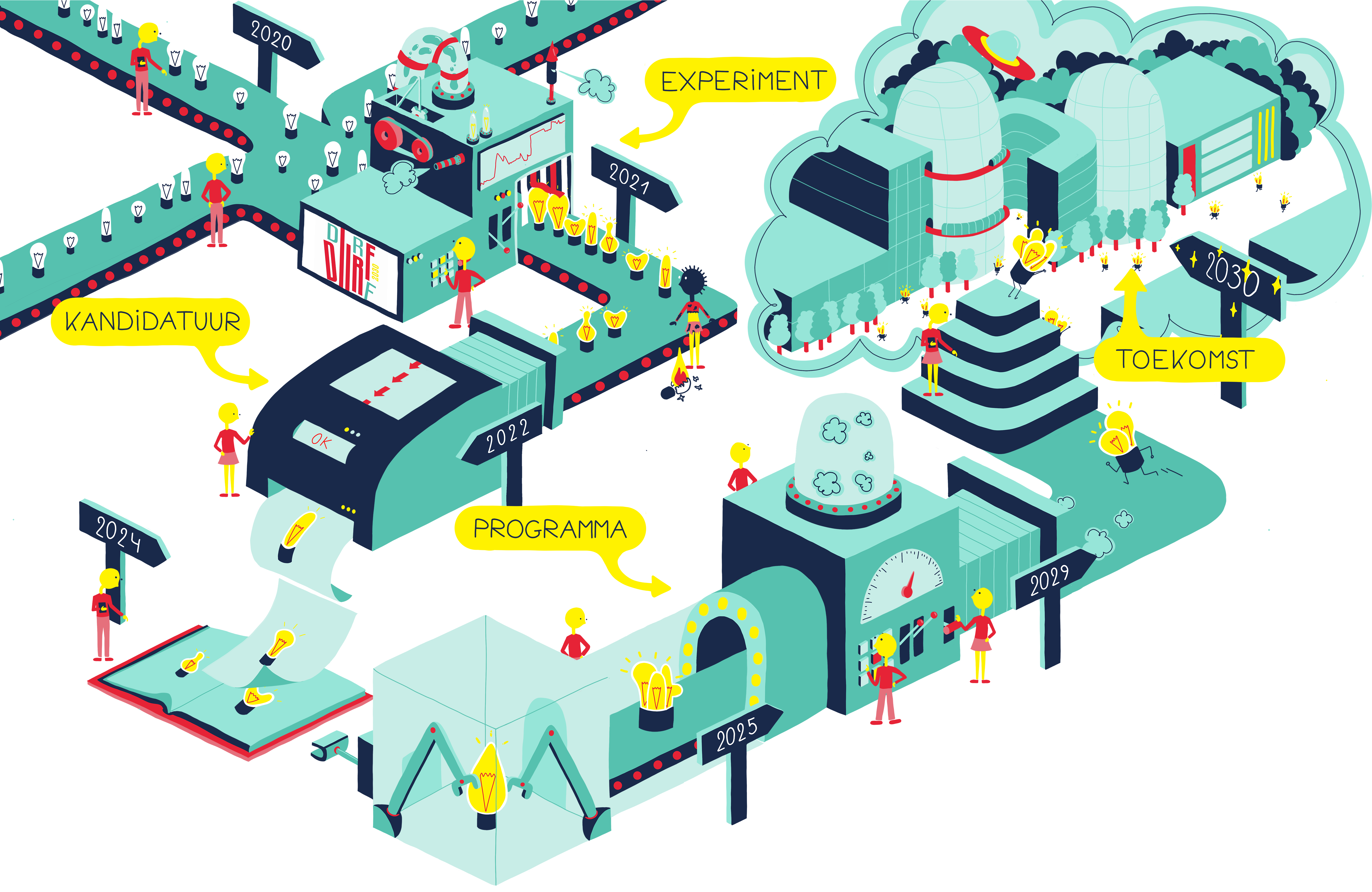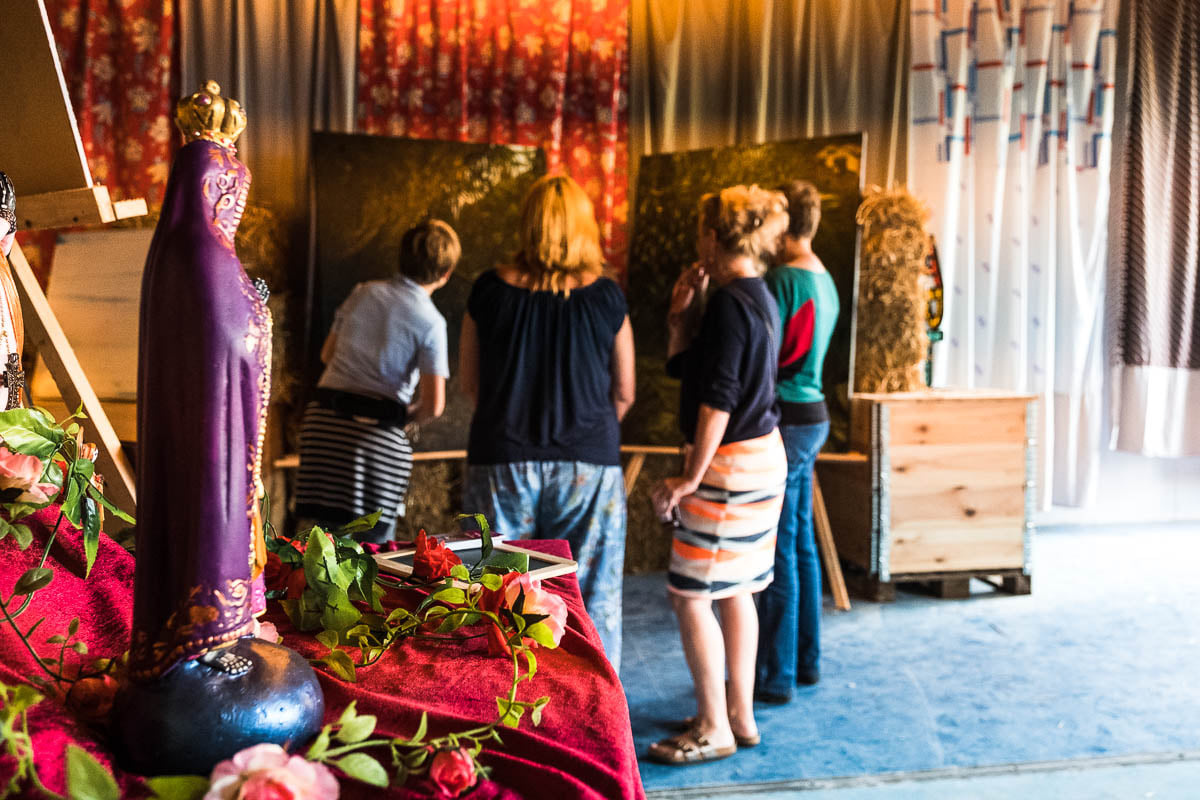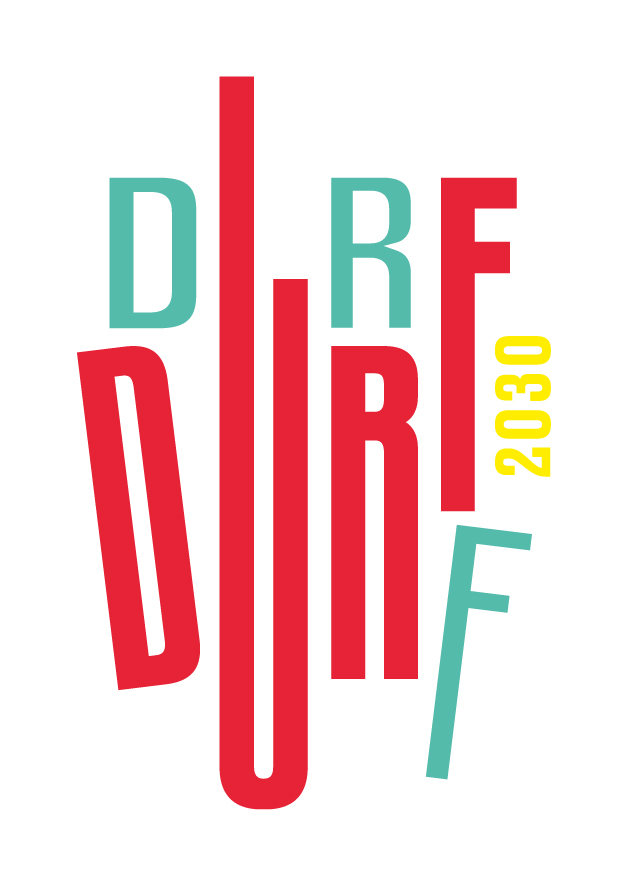DURF2030 unites bold people and do-ers, connectors and change-makers, thinkers and entrepreneurs who, from a creative mindset, set up concrete experiments to build a resilient region that inspires residents and visitors, makes them dream and makes them proud.
DURF facilitates impactful projects in the run-up to the candidacy for European Capital of Culture 2030: what role can art and imagination play in durable transitions in South-West-Flanders? Facing the future with courage and imagination.
As a city and a region, we face major socio-economic challenges. These are putting our society under pressure. DURF2030 is a platform made of citizens and organisations with different backgrounds, who use the creative mindset as a tool for positive change in our city and region.
DURF2030 is a cross-sectoral platform (quintiple helix), a regional and innovative ecosystem, that proactively creates opportunities for transition. We support everyone who takes action to tackle the challenges in our region. DURF2030 supports the actors as a facilitator who drives, connects, shows and inspires.
DURF2030 is an experimentation space that stimulates action, bottom-up, because everyone is an actor of change. DURF2030 works on the basis of trust and freedom, ownership and innovation, respect and involvement, daring and pleasure. We have a fluid organisational form, where everyone determines their own role and commitment, a collaboration between art and cultural partners, educational institutions, businesses, politicians, citizens etc.
DURF2030 strives for 2030 projects by 2030 based on the belief that many (small) changes accelerate the large sustainable changes that are needed. Dare to tackle the future, dare to go for change, regardless of how small it is. Creating a sustainable community starts locally.
DURF2030 is a project of at least 10 years and thinks far beyond 2030. Time that is necessary to achieve sustainable cooperation, sustainable impact on our region and growth in commitment and confidence in the future. We see European Capital of Culture 2030 as an accelerator in the transition, whereby DURF2030 is deployed as a vehicle.
DURF2030 illustrates how cultural and aesthetic experience is much more than traditional views, from a committed, connected, dynamic and future-oriented vision.
Please highlight how the project can be exemplary in this context
DURF2030 has objectives in terms of sustainability in 3 ways:
- First, DURF focuses on sustainability in partnerships. Sustainable solutions only come about by approaching challenges from various standpoints. The growth of these collaborations takes place in various phases (from exploring, to finding shared interests, to negotiating, taking action together, repositioning etc.). The strength of our open platform lies in the speed at which collaborations take shape, discovering each other while doing projects together.
- Secondly, DURF aims for a more sustainable environment and society. We focus on projects that turn our region into a sustainable and resilient one, also for future generations, by taking into account the social and ecological boundaries of our society. Projects that focus on behavioural change regarding waste, circular economy, child-friendly streets, care for people and nature, etc. have their place with us.
- Thirdly, we are going for DURF as a sustainable and flexible operation. We do this in 3 phases. In the first phase (2020-2023), believers initiate smaller experiments, bottom-up, from a coalition of the willing. In this way, we create the ground layer of our ecosystem, we investigate the challenges, the tool of creative mindset and the impact of these experiments. (Currently 44 projects and over 250 members).
In the second phase (2022-2024), we will use the accumulated knowledge and the extensive network to set up a larger project together, based on a shared challenge: the transition of work. We will be experimenting with organisational models, setting up partnerships with businesses and workers in order to reach them with creativity within their own context.
The third phase (2024-2030) is the run-up to European Capital of Culture 2030. That year will be a flywheel for change, an accelerator towards the resilient region of the future. In this phase, we will continue to focus on experimentation and research in order to improve ourselves.
Please highlight how the project can be exemplary in this context
DURF2030 focuses on impact projects by using a creative mindset as a tool for change. Creativity and imagination are necessary skills in the 21st century and we use them not only as a tool in the thought process, but also when developing projects.
We launched 44 projects, some of which focus on design and architecture, others reach their goals through dance and visual arts, others through service design. An example of a project is 'LOF', where an empty church in a developing area was used to make the neighbourhood liveable, to give substance to vacant properties and to put artists in the spotlight who very often remain under the radar. It is a beautiful project that illustrates how creativity in the public space creates a quality experience, both for the neighbourhood & the building, as for the artists and visitors.
The Prototype23 project will primarily result in new services through creative mindset and art thinking, but will also result in a cultural event in the autumn of 2023 where the wider public will be engaged in a shared experience of imagination about all the experiments about the future of work in the region.
We want to illustrate that "culture" is broader than the traditional conceptions:
- Culture is not only about "great" achievements in art and science, but it is also a hybrid vision in which connections are made between citizens, artists, governments, companies ...;
- Culture is not just the display of a community's "folk character" or its habits and behaviours, but it is the shared energy of a community to look ahead, change and innovate;
- Culture is not only the behaviour of a community that we are proud of, but is also the enthusiasm to see that embedded behaviour as something with the potential for change, as something dynamic.
- Culture is not only an surprising, but non-committal look into the past, it is also a hopeful and committed look into the future. It’s about a collective experimentation with new manners and future lifestyles.
Please highlight how the project can be exemplary in this context
DURF2030 brings people together. It offers citizens, artists, organisations etc. with the drive to change something the opportunity to realise an idea. Our aim is to detect and tackle social challenges, together with citizens. Each actor starts from a challenge in our region. After forming a coalition with other partners/sectors, they develop a project themselves, from start to finish. Our platform offers support, ownership remains in the hands of the individual. We strongly stimulate the power to fail; people are allowed to experiment. We do this on the basis of design thinking.
We also aim for co-creation on a large scale, working across sectors. Our open platform (an innovative ecosystem) works with various groups, from money-makers to research groups, project groups and communication groups. Any actor can join each group and in everything we apply the principle of: "The doers decide, and the decision makers do".
Essential partners in DURF are those that work specifically on vulnerable groups and minorities. They are part of our working groups. For example, we have Refu-interim, which employs newcomers, and FMDO, an umbrella organisation of self-organisations of different cultures.
Many projects developed by citizens are very accessible. An example here is ‘Wachtverzachter'. Yara, a young woman from Kortrijk, was annoyed by the long waiting time at a drawbridge in the city centre. She developed an installation that brings about interaction between the people waiting on both sides. A playful social interaction to make the waiting easier.
All these smaller, experimental projects show us what works and what doesn't work. We learn by doing, by trial and error. The low threshold of the projects keeps it inclusive.
DURF2030 shows how many citizens, volunteers, employees, creatives in the region can be engaged and actively involved in the creation of positive impact. Our change starts locally, but has the potential to spread to Flanders and eventually Europe.
Please highlight how this approach can be exemplary
We start from the belief that imagination is needed to shape our future, that doing and feeling makes us believe that things can be done differently. We experiment in order to shape the future. We start from the power to fail and the power to be uncertain. We are a fluid operation that adapts to the needs of the various project holders and actors in the network.
Within our projects, we focus on sustainable partnerships and sustainable interaction between people and nature in an urban context. These collaborations and interactions are done in a participatory and co-creational way. Every individual can participate in an accessible way. Either as the initiator of a project, as a participant in a project or as an observer of a project. In this way, we strive towards optimal inclusion.
Finally, art and creativity are used as tools in our projects. A tool that enhances the quality of the experience, a tool that can touch the deepest part of a human being and trigger reflection and action, as well as optimising the environment.
With DURF2030, we start from the challenges within the socio-economic fabric of our region. The impact we want to achieve is on various levels:
- Impact on specific challenges in our region:
- On the one hand, through the multitude of bottom-up projects around self-selected challenges, but also thematic calls (around loneliness, care for people and nature, behavioural change in public spaces): these projects primarily provide a basis for discussion, dialogue and research around the challenges. A foundation and catalyst for change.
- On the other hand, through larger (partly bottom-up, partly top-down) projects around a common challenge. For example, Prototype23 around the transition of work: here we strive to change the mindset, to effective experiments that can be rolled out in other sectors and areas, but also to impact on new and sustainable cooperation models.
- Impact on the bold and the do-ers: Those who are actors in the story are inspired, are stronger through cooperation, are proud and enjoy the experiment, their creative ability, power of failure and uncertainty are increased. We are forming a community of actors for urban change. The future is made by those who shape it, only then does sustainable transition occur.
- Impact on the region's citizens: citizens of the region who participate in projects, are spectators or see messages pass by, feel proud of the region and are more hopeful about the future.
Please also explain the benefits that derived from their involvement.
DURF2030 is a facilitating platform. Which projects are proposed and implemented is decided by the actors themselves. We advise and assist them and also help with promotion and implementation. We facilitate, but the actors do it themselves. In this way, we go for a maximum level of ownership. With DURF, we have a strong hands-on mentality. We concretise this in a cooperation model in which everyone has an equal say. Each project owner becomes an actor for urban change.
The DURF innovation ecosystem is a democratic body, very open and accessible to everyone. Each partner can become part of the ecosystem according to its own capacity (desire, expertise, time, etc.). The commitment is also fluid, one can at any time scale up the commitment, adjust it or stop it.
One of the working groups in the ecosystem is a steering committee that sets the strategy, but this group also consists of a mix of partners, entrepreneurs, citizens, etc. Our principle is 'the doers decide and the deciders do'. So the project owners also help determine which way we go, how the project will take shape. They are at the wheel of DURF2030 and the transition.
The projects within DURF2030 are focused on the South-West Flanders region, so they remain local and realistic. We tackle various global challenges. We involve a very diverse group of people and roll out our projects in real life. This brings about social cohesion and thus we try to give an answer to the increasing loneliness and polarisation.
In addition, we activate young people and, by extension, the entire population. We help people to find a goal and offer them a place to make a meaningful contribution to society. By taking matters into their own hands, they become proud and hopeful.
We also work on the democratic process. By actively involving citizens, we give them a greater say and provide them with a place where they can obtain change. In this way, they become a small part of the policy.
Finally, each project starts from a regional challenge. There are projects that focus on the future of work, on vacancy, physical and mental health, positive rewards, etc. In addition, we also work with thematic calls to attract projects that highlight specific challenges: loneliness in times of corona, behavioural change in public space and finally Dare to Care, where we bring care for people and nature closer together. A fourth call is starting now, on the transition of work (Prototype23).
There is a great need to achieve both economic and social goals. We see an important role here for regional innovation ecosystems such as DURF2030. In plain language: in the field of innovation, great things can happen if local authorities, educational institutions, artists, citizens and businesses join forces. It is clear that a common goal and shared interests are necessary in order to move forward together.
Orchestrating this cooperation with all the parties involved in an ecosystem requires the direction of a prominent and neutral party that can switch between governments, businesses and citizens alike and align interests. This director encourages cooperation at the right time and in the right form in order to develop innovations and make them successful. The DURF2030 team takes on this role.
This director deals with issues such as:
- How do you involve the right parties at the right time?
- How do you develop a good climate for innovation?
- How do you create a shared vision for change?
- How do you determine which innovations are needed, and when?
- How do you deal with the complexity and different interests in your ecosystem?
- How do you stimulate the realisation of innovation in practice?
This innovative organisational structure, together with our approach of cross-sectoral cocreation, art thinking, bottom-up participation, courage, the power to fail and the ability to sense uncertainty make us unique in Belgium.
In addition to this innovative structure and approach, we run for the most part on voluntary commitment, both from citizens and from various professional organisations, which share the same ambition. Finally, we have an open source ecosystem, where transparency and shared ownership are key. We take 10 years to build sustainable relationships, connection and a do-it-yourself mentality.
The combination of all these things makes DURF2030 innovative and daring to be experimental, in line with the Bauhaus ambitions.
Please provide clear documentation, communication of methodology and principles in this context.
Our project started in 2020, so there is not much documentation yet. We are using our website www.durf2030.eu as a learning platform. Today, we are often put forward as an 'example project', for example at OP TIL, a supra-local organisation (Flemish) with similar objectives.
Because we work cross-sectorally, it happens that solutions for one sector are also implemented in other sectors. We see something similar in geography. An experiment with a focus within a city is eventually rolled out over an entire region. The output then spreads like an oil slick.
In 2021, we started a two-year project in which we specifically focus on young people within the DURF2030 operation and look for tools, methodologies and impact measurement via art-based research in collaboration with Vives, a University College in Flanders. This project will result in a roadmap and toolkit, transferable to other cities, parties and contexts.
With the 'prototype 23' project, we are testing, as the word itself indicates, how we can work in a large partnership of various actors around a common challenge. This project is well documented. From this we develop a project-led strategy that will lead Kortrijk towards the European Capital of Culture in 2030. But it is also a transferable strategy to other places in Europe, regardless of a candidacy.




@Stad Kortrijk, 2020
Content licensed to the European Union.